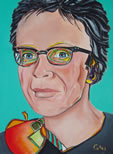useNature.com ... Essential Oils – Aromatherapy
Aroma Essential Oils
Natural Health Lifestyle Online Magazine
Holistic Health & Lifestyle Information
Article: Essential Oils and Aromatherapy
Essential Oils – Aromatherapy - An Introduction
Compiled and Edited by Dieter Luske N.D.-D.C.H.-D.M.H.-D.H
Holistic Therapy Consultant - Gold Coast - Canungra
What are Essential Oils?
Aromatherapy makes use of Essential oils
To find a Therapist, please click >> Aroma Therapy
Essential Oils
The odoriferous substances, or Essential oils themselves are formed in the chloroplasts of the leaves where they combine with glucose to form glucides and are then circulated around the plant in this form. At certain times of the day or year they are stored in particular parts of the plant.
In some plants, the essential oils are produced by the secretory tissues, and in others they are combined with glycosides, and are therefore not detectable until the plant is dried or crushed, e.g.: Valerian
Essential oils are considered to be an important part of the plant's metabolism: some have hormonal activity and others are a stage in some other process, e.g.: the oil found in the rind of the orange is a stage in Vitamin A synthesis.
Essential oils can be found in almost any part of the plant, in differing concentrations, depending on the plant itself, the time of day and year. They may be found in the roots (e.g.: Calamus and Valerian), flowers (e.g. Lavender, Rose,), bark (e.g. Sandalwood, Cedarwood), fruits (e.g.: Lemon, Cardamom, Orange), berries (e.g. Juniper), leaves (e.g. Thyme, Rosemary, Sage).
Plants which contain essences must be picked at the correct time of day and in the correct season, and in particular weather conditions in order that a maximum yield of the essential oils can be obtained, and of course, as with all medicinal or nutritional plants, soil conditions, and climatic conditions will also dictate the quality of the oils obtained.
Heavy, concentrated oils are called ABSOLUTES e.g.: Rose, Jasmine, Oils which are solid at room temperature and which must be warmed before use are called BALSAMS, e.g.: Benzoin and Camphor.
HOW DO ESSENTIAL OILS WORK?
Essential oils are known to have an effect on us in three different, but overlapping, ways.
-
On the physical body, both locally and systemically, via the lymphatic and blood circulation.
-
On the mind and emotions via the Sense of Smell and the Limbic System.
-
On the “Etheric Energy System” of the body via the energy vibration of the individual oils themselves.
The Way Essential Oils Effect the Physical Body
When Essential oils are applied to the surface of the body, either via Massage, Baths, Compresses, Creams or Lotions, they will have an effect locally (i.e. the site at which they are applied), and Systemically (i.e. throughout the body).
The Systemic effect occurs when essential oils are absorbed through the skin into the Lymphatic Circulation, and they are then transfered from the Lymphatic circulation into the blood stream.
Once the oils are circulating in the blood, they are carried to their TARGET ORGAN/S, where they exert a therapeutic effect on the specific tissues.
Every Essential oil has its own Target Organ, e.g. Juniper oil targets the urinary tract and kidneys in particular, with secondary effects on the Digestive, Respiratory and Reproductive Systems. Chamomile Oil targets the Nervous System via which it can then exert a broad effect on many other body Systems, like the Digestive Tract for example.
Even when Essential oils are inhaled only, say in the form of a steam inhalation for a cold or as a fumigator for a background “psychological” effect, the oils will be absorbed across the mucous membranes of the Respiratory Tract and lungs into the blood stream, where once again, they can travel around the body very rapidly.
If Essential Oils are taken orally, their absorption through the Mucosa of the stomach and into the blood is very rapid.
NOTE: Very few essential oils are actually ‘digested’, which is fortunate as their Therapeutic principles may well be altered if this were the case.
The reason why Essential Oils behave in this manner in the body is because the molecules of which they are composed are organic molecules and very small indeed.
Below are some of the more common Therapeutic Properties which can be obtained by using Essential Oils.
SOME THERAPEUTIC PROPERTIES OF ESSENTIAL OILS
1. ANTISEPTIC
All essential oils are to a greater or lesser extent ANTISEPTIC. This is one of their most important and valuable properties.
This broad description of ANTISEPSIS includes anti viral, antifungal, anti-bacterial and general anti-microbial activity which is found in such oils as: Lemon, Thyme, Tea Tree, Garlic, Eucalyptus, Cinnamon, Pine, Lavender and Sandalwood.
2. ANTI-INFLAMMATORY
Oils with this property help to ease inflammation. The symptoms of inflammation are typified by pain, redness, swelling, and partial or total loss of function of the tissue involved. Examples of oils with this property are Chamomile, Rose, Lavender, Sandalwood, Myrrh and Benzoin.
3. CYTOPHYLACTIC
Restoration of tissue function and regeneration of cells is another outstanding property of essential oils. Oils such as Pine, Basil and Rosemary are known to restore function to the adrenal glands, Jasmine, Cypress, and Ylang Ylang restore function of reproductive endocrine glands, lavender and chamomile stimulate cell regeneration in the skin.
4. SEDATIVE
Essential oils may also have a pronounced effect on the nervous system by producing relaxation, pain relief and relieving muscle spasm. Oils with these properties include Lavender, Neroli, Rose, Geranium and Ylang Ylang.
However, the most outstanding property possessed by essential oils is their antiseptic/antigenetic property.
This is well documented in Dr Jean Valnet's book, "The Practice of Aromatherapy" and he discusses at length the effects of specific oils in relation to the control of extremely virulent microbes like Meningitis bacteria, Golden Staphylococcus bacteria and typhoid bacteria.
Undertanding above principles, helps to appreciate the ways in which essential oils can have both a healing and preventive role in diseases involving invasion of the body by microbes.
Article compiled by ...
the editor of Use Nature, Dieter Luske
Article provided by : Danny Siegenthaler
* Disclaimer - Any general advice given in any article should not be relied upon and should not be taken as a substitute for visiting a qualified medical Doctor.
 Dieter Lüske - Editor
Dieter Lüske - Editor
N.D.-D.C.H.-D.M.H.-D.H
Aroma Therapy Bag
Pillow
Aroma Apparel
Aroma iPad Skin
Healing with Art
creative art classes
all levels - all styles
individual teaching
Gold Cost - Hinterland
© 1998 - 2025 useNature.com: Australia - Dieter Luske - Writer - Creative Lifestyle Portal - Natural Holistic Health - Books & Art -
*Disclaimer: Information provided is intended for general/personal use only. It should NOt be understood as medical advice.






